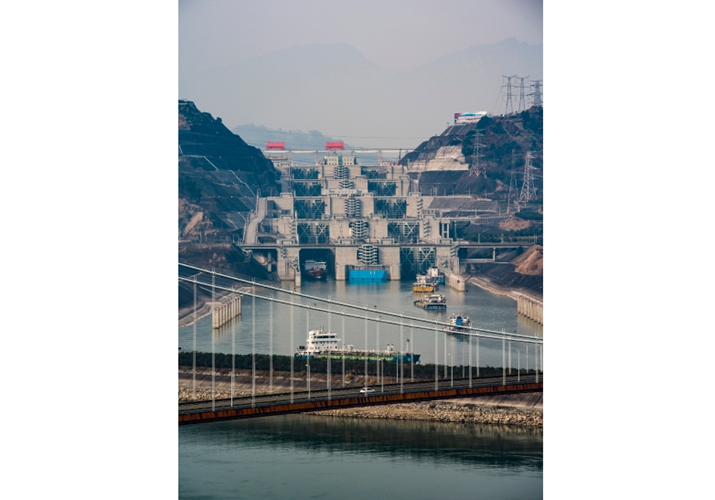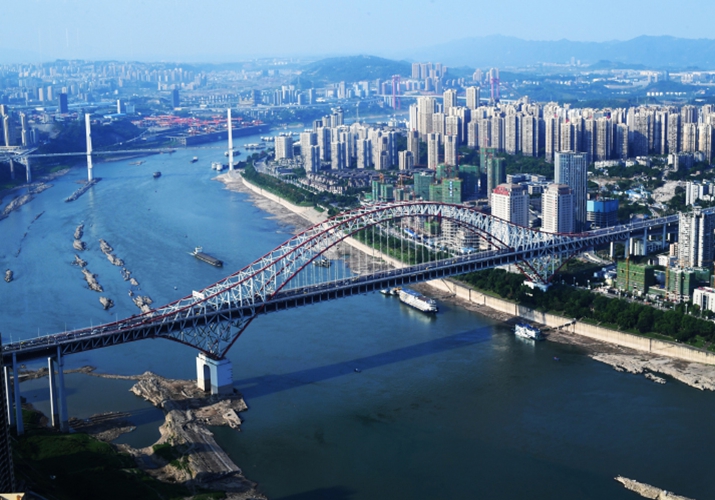Vessels pass through the ship lock at the Three Gorges project in Yichang, Hubei Province in central China, on January 10 (XINHUA)
Chen Fu, an associate research fellow with the Aerospace Information Research Institute, the Chinese Academy of Sciences, studied the changes taking place along the Yangtze River Economic Belt by comparing satellite images of lights across the region. "The lights are visibly turning brighter over the past five years," he said, adding that the increase in brightness usually stems from more active production and human activities.
His conclusion is backed by official statistics. As of November 2020, the economic belt accounted for 46.6 percent of China's economic aggregate, up from 42.3 percent in 2015. Its total trade in goods hit 12.7 trillion yuan ($1.96 trillion).
The Yangtze is China's longest river and the world's busiest inner waterway in terms of cargo flow. Development of the Yangtze River Economic Belt, which covers 11 provinces and municipalities and is also home to over 40 percent of the country's population, is a national strategy.
The recent economic growth did not come at the expense of the environment as in the past. Five years ago, President Xi Jinping presided over a meeting on the economic belt, saying the status and role of the river and the economic belt meant that development must prioritize ecology and green development, which unveiled a new chapter for regional development.
The satellite images Chen used for research also show that the lights of mines and chemical industrial parks in some areas on both sides of the Yangtze have already diminished.
A new face
According to the National Development and Reform Commis-sion (NDRC), more than 8,000 chemical enterprises have been relocated or closed down along the economic belt over the past five years.
In Changzhou, Jiangsu Province in the lower reaches of the river, there were 84 chemical enterprises along the 25.8-km shoreline in 2019. Villagers said these projects brought both income and pollution.
By the end of 2020, the number had been reduced to 41. "The primary task is to alter the path of development," Xu Yawei, an official of the Binjiang Economic Development Zone in Changzhou, told People's Daily.
The chemical industry was an economic pillar of many cities in the belt. In Yichang, Hubei Province in the middle reaches of the river, chemical companies contributed one third of the city's industrial output. After the strategy of green development was established in 2016, new and hi-tech industries such as new materials, biomedicine, information and advanced equipment manufacturing have thrived and they currently make up 41.9 percent of Yichang's industrial output, according to the local government.
With the relocation and closure of polluting enterprises, the water quality in the Yangtze has seen remarkable improvements. According to the Ministry of Ecology and Environment, in the first 11 months of 2020, 96.3 percent of the river met the Grade-III standard or better, rising 14 percentage points from 2016. China classifies water quality into six levels, from Grade I, which is suitable for drinking after minimal treatment, to Grade VI, which is severely polluted.
Building on these environmental achievements, a new law on Yangtze River conservation will take effect on March 1. This law was formulated to enhance the protection and restoration of the ecological environment of the Yangtze basin, facilitate the effective and rational use of resources, safeguard ecological security, ensure harmony between man and nature, and achieve sustainable development.
To help the waterway recover from dwindling aquatic resources and degrading biodiversity, a 10-year fishing ban in the Yangtze formally took effect on January 1. The measure covers 332 conservation areas along the river.
According to the Ministry of Agriculture and Rural Affairs, as of September 2020, nearly 95 percent of fishing boats in key water sections had been grounded and 50 percent of former fishermen had been employed in other industries.
Green development efforts have paid off, but challenges remain. Zhao Shixin, an official with the Ministry of Ecology and Environment, admitted at a press conference in Beijing on January 5 that there is a long way to go to establish long-term ecological protection system along the economic belt, citing problems including untreated wastewater discharges and recurring cyanobacteria blooms.
A bird's-eye view of Chongqing in southwest China, on May 6, 2020 (XINHUA)
A dynamic belt
The coordinated development strategy has made industrial cooperation within the economic belt closer and facilitated inland regions' access to overseas markets. Currently, three poles of growth have formed along the economic belt: the Yangtze River Delta including Shanghai, the city clusters in the middle reaches of the river with Wuhan as a major powerhouse, and the Chengdu-Chongqing economic circle in the upper reaches.
Every day, freight vessels loaded with products made in Chongqing depart from the Port of Guoyuan down to the Port of Taicang in Jiangsu. From Taicang, the goods are transferred to the Port of Yangshan in Shanghai for delivery to overseas clients.
An express line between the three ports opened in 2020. "The line is 30 percent more time-efficient than regular ones," Niu Xiandan, General Manager of an international logistics company based in Chongqing, told People's Daily.
Networks of high-speed railways and expressways in the economic belt have also improved significantly. As of November 2020, the total railway mileage of the economic belt reached 43,700 km, up 9,120 km from 2015, according to the NDRC, which laid a solid foundation for regional integration.
Xi emphasized at a symposium in Nanjing, Jiangsu, in November 2020 that cities along the economic belt should play an active role in implementing the dual circulation development paradigm and take the initiative to open up their markets to the world. First proposed last May, dual circulation refers to making the domestic market (internal circulation) the mainstay, supplemented and reinforced by the global market (external circulation).
Zeng Gang, head of the Institute of Urban Development, East China Normal University, said major cities in the economic belt should work together with small and medium-sized cities to promote industrial upgrades and explore environmental protection solutions so as to advance coordinated development in the future.
The past five years have seen the economic belt move forward in the pursuit of greener, more sustainable and high-quality development. As the country steps up efforts to develop its "mother river," the golden waterway will see a brighter future.
(Print Edition Title: Mother River's Legacy)
——
Quick Facts About the Yangtze River
Originating on the Qinghai-Tibet Plateau, the Yangtze River is China's longest waterway, running more than 6,300 km through 11 provincial-level regions before emptying into the East China Sea.
A number of the country's economic powerhouses, megacities and major rice-producing areas are located along the basin of the Yangtze, the world's third longest river. The Three Gorges project on the upper middle reaches of the river is the world's largest hydropower project. The vast multi-functional water control system consists of a dam stretching 2,309 meters long and 185 meters high, 32 hydropower turbo-generators, a five-tier ship lock and a ship lift.
In 2019, 2.93 billion tons of cargo was shipped through the main reaches of the Yangtze, an 8.9-percent increase from 2018, ranking first among the world's inner waterways in terms of cargo flow.
The Yangtze River Economic Belt along the golden waterway comprises Shanghai and Chongqing municipalities, as well as Jiangsu, Zhejiang, Anhui, Jiangxi, Hubei, Hunan, Sichuan, Guizhou and Yunnan provinces. It accounts for more than 40 percent of the country's population and economic aggregate and is also home to nine of the country's 21 free trade zones.
The Yangtze River Delta, covering Shanghai and neighboring provinces of Jiangsu, Zhejiang and Anhui, is one of the most populated and urbanized city clusters in China. It is also one of the country's most economically active regions.
Shanghai, the sixth largest city in GDP terms globally, is home to 758 regional headquarters of foreign-funded multinational companies and the regional headquarters of nearly one fourth of Fortune Global 500 companies.
(Source: Xinhua News Agency)
Copyedited by Sean Connolly
Comments to zhangshsh@bjreview.com

